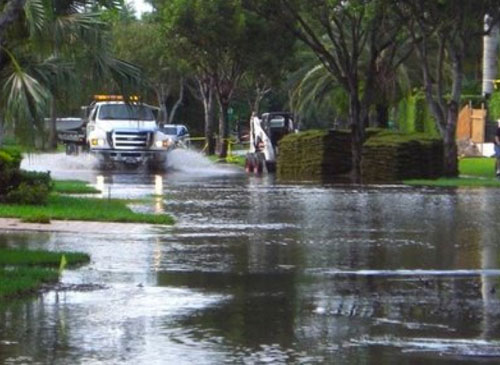As you considered the home's curb appeal, did you consider the property's risk of flooding in the next 30 years? Probably not, but it could have.
According to new research made available exclusively to Bloomberg, potential homebuyers who reviewed property listings that included flood risk were less likely to look at and bid on homes in areas with a high risk of flooding.
In short, risk transparency is important, according to Daryl Fairweather, Redfin's chief economist. The study was carried out in collaboration with the University of Southern California, the National Bureau of Economic Research, and the Massachusetts Institute of Technology.
"Climate change is actually influencing people's economic decisions," Fairweather said in an interview. "We didn't have any proof of that before. Not in the housing market, for sure. And now we know that if you give someone information about future flood risks, it will influence whether or not they decide to buy a home."
Redfin ran an experiment on 17.5 million of its users in the United States from October 12, 2020 to January 3, 2021. As prospective homebuyers entered the site, Redfin randomly assigned them to one of two groups: those who were shown flood-risk information on each property and those who were not.
First Street Foundation, a climate and technology nonprofit that works to make climate hazards more visible to the public, provided the flood-risk scores. In June 2020, First Street released the first public flood risk maps for every home and property in the contiguous United States.
The Federal Emergency Management Agency had previously created public flood maps, but they only included areas at high enough risk to be covered by the National Flood Insurance Program. Even those maps, as FEMA Administrator Deanne Criswell recently admitted, are far out of date due to increased flooding caused by climate change. When First Street released its maps, it included roughly 6 million more homes in high-risk areas than FEMA.
On a scale of 1 to 10, First Street's Flood Factor scores estimate the likelihood that a property will flood at least once in the next 30 years (the typical mortgage term): minimal (1), minor (2), moderate (3-4), major (5-6), severe (7-8), or extreme (9). (9-10). When they were first released, the big question was whether they would have any effect on the market.
According to Redfin's research, prospective buyers were reactive to severe flood risk, particularly in cities with known flooding problems. Users in Cape Coral, Houston, and Baton Rouge, Louisiana were the most likely to navigate to the flood-risk section of home listings.
However, users' behavior changed over time as a result of the information. After one week of exposure to flood-risk data, those who had previously looked at extremely risky homes were looking at homes with 7% less risk than the control group. When compared to the control group, the properties they were viewing were a quarter less risky after nine weeks.
A larger shift was observed in a subset of users, those working with Redfin agents or partner agents who had previously viewed homes with an average flood-risk score of 8.5. After gaining access to flood-risk data, they went on to view homes with an average score of 3.9, a 54% decrease.
Not everyone was affected by the data. Any flood risk less than severe barely moved the needle on user behavior. And net inflows of people continue to occur in flood-prone areas. Tampa, Cape Coral, and North Port in Florida are all consistently ranked among the top migration destinations by Redfin. Most buyers are still primarily concerned with traditional factors such as price, warm weather, and lower taxes.
However, Fairweather believes that because the majority of the market has not yet adjusted to more transparent flood information, current homeowners have a window of opportunity.
"Home prices have not yet begun to fall broadly as a result of natural-disaster risk." "This means that communities facing the greatest risk still have time to act," she explained. "If a homeowner believes their property's value will decline due to flood risk, they may want to relocate now to protect both themselves and their finances."














